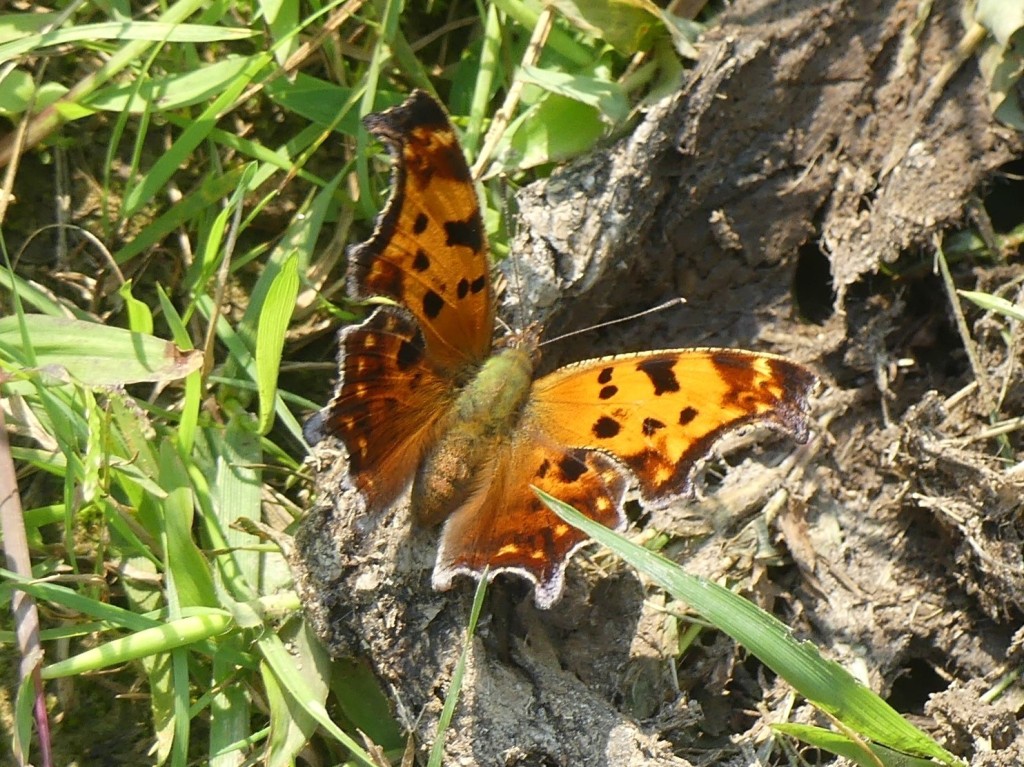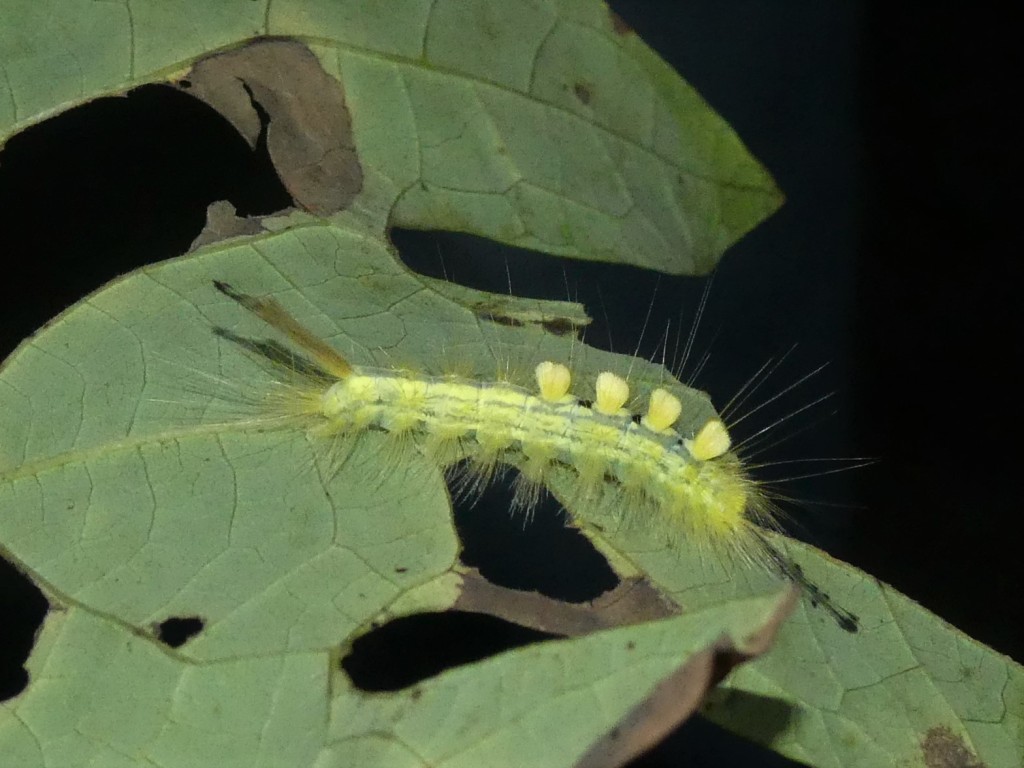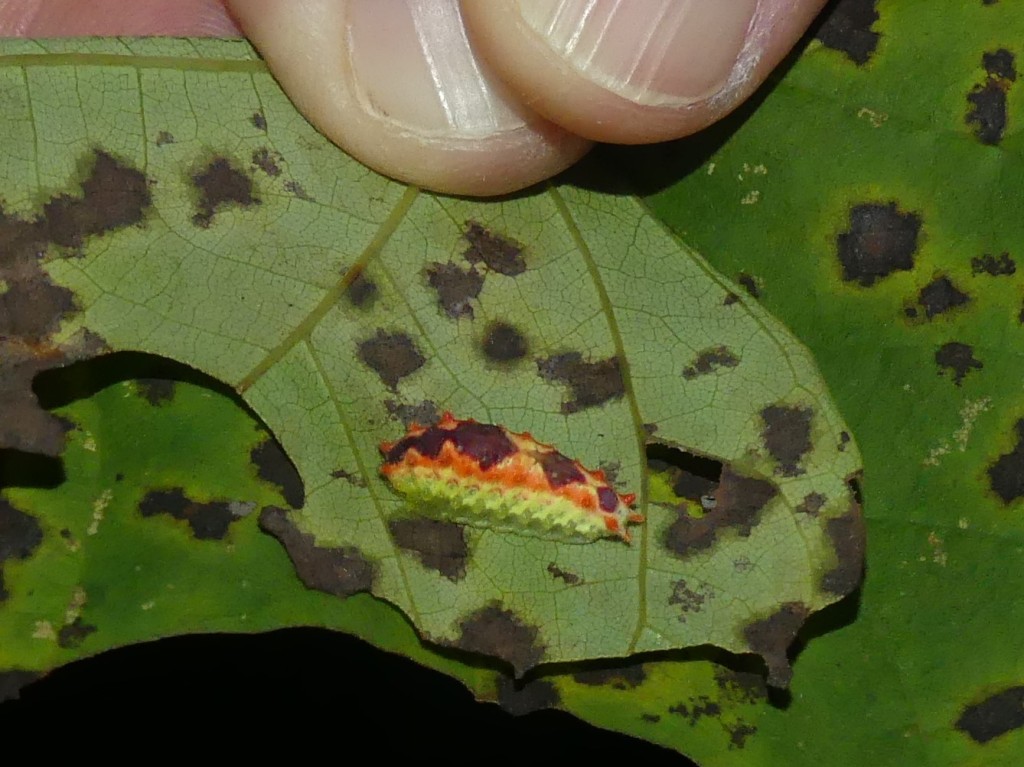I’m not a night photographer. My experience at that is zero…until recently.
I attended the Shawnee Nature Safari, a weekend program hosted by the Midwest Native Plant Society this past September. It was held at Shawnee State Park in southern Ohio and involved both day and evening hikes. Come along with me now as we explore the things that crawl in the night, and in the daytime. Some of them I guarantee will surprise you!

Okay, yes you’re right, a butterfly is not something that crawls in the night, but bear with me. Before this magnificent Eastern Comma butterfly emerged from it’s chrysalis, it was a caterpillar. And caterpillars do indeed crawl around in the night. Many prefer to feed at night so as to avoid detection by predators in the daytime.

Remember that beautiful Eastern Comma butterfly photo you just saw? Well, this (photo above) is what the Eastern Comma caterpillar looks like. Host plants for this caterpillar include nettles, elms and hemps. Adult Eastern Comma butterflies will overwinter under tree bark, leaves and similar locations, while most other caterpillars overwinter in a cocoon or chrysalis. I believe there are only about four or five butterflies that overwinter as adults in Ohio.

The Question Mark butterfly is very similar in appearance to the Eastern Comma, but the Question Mark caterpillar (above) has different coloring compared to it’s Eastern Comma “cousin.”
The Silver Spotted Skipper are plentiful in central Ohio. For identification purposes, skippers fall somewhere in between being a butterfly or a moth. Here’s a photo (below) of one on Bergamot.

And here’s what the Silver-Spotted Skipper looks like in caterpillar form. Tiny and cute! Looks like something from a cartoon doesn’t it?

Caterpillars are easier to find at night if you use a UV flashlight. The little creatures will gently “glow” in the dark and help you detect them. However, it’s very important that should you disturb these for a photograph that you return it to the same tree or shrub afterwards. Some caterpillars are generalists eating many different types of plants, while others are specialists and will only be able to eat from a particular plant/tree.
One type of caterpillar that is seen quite readily is the Tussock moth. There are several species of these rather nondescript moths with their brown/tan/gray coloring. But their caterpillars are anything but nondescript.

The one in the photo above is a Banded Tussock moth caterpillar. Actually, this is really a tiger moth caterpillar, despite it’s name.

The cute little pale yellow caterpillar above will become a Sycamore Tussock moth, named appropriately because its host (and preferred) plant is the Sycamore tree although it will eat other plants.

The photo above is a Definite Tussock moth caterpillar. Quite different in color and appearance from the other two. But beware, touching any of these Tussock caterpillars can cause a very uncomfortable itchy rash.

Another caterpillar that appears visually similar to the Banded Tussock is the American Dagger. This caterpillar will also cause a very itchy rash if touched, so be very careful when photographing these. The American Dagger moth is another rather nondescript moth of multiple shades of tan and gray. But I find this shaggy caterpillar adorable!

Here’s another interesting caterpillar. This one is a Spotted Apatelodes which is covered with what appears to be soft hair and sporting red “boots” on it’s little legs. Cute, but I’ve also read the caterpillar is poisonous although the adult moth is not.

At first glance, one might think this is some type of cocoon, but it’s the Black-Waved Flannel caterpillar. Cute but avoid at all costs! The hairs can embed into the skin and make one very sick. The moth on the other hand is a rather shaggy looking tan and brown but alas, also very dangerous to touch.

And while we’re looking at rather hairy caterpillars, here’s another one – the Delicate Cycnia moth caterpillar – also known as the Dogbane Tiger moth. And with good reason, as they they prefer milkweed species, especially Dogbane. This one was rather easy to find, as most of the leaves were stripped from a Dogbane plant with about eight of these caterpillars feeding on it.
Okay, we have now covered quite a few hairy caterpillars, how about we look at some with very distinctive shapes and colors?

This cute little one is an Io (eye-oh) caterpillar. And also one you should never touch. I wish I could share a photo of the Io moth, but I’ve never been fortunate enough to photograph one (and I try to use only my own photos in this blog.) The moth is very beautiful. Predominantly yellow with big black “eyes” on its hindwings. Well worth searching for a photo online to see it!

This tiny little caterpillar is a Purple-Crested Slug moth and is (yes, you guessed it) a species of slug caterpillar moth. They are generalists and can feed on a variety of trees and plants. Their “slug” name comes from the caterpillar’s resemblance to slugs.

This little guy is a Spiney Oak-slug caterpillar. Also a member of the slug moth family. I’ve read the spines are venomous and can cause serious health issues if handled. While “oak” is in the caterpillar’s name, they also feed on cherry and willow species as well as oaks. The moth is dark brown with pale green splotches on its wings.

And here’s yet another spiney looking caterpillar. This one is the Saddleback, appropriately named with it’s cute little brown and green “saddle.” Yes, it’s also another slug moth. And one you need to avoid because of its venomous spines.

This orange beauty (about an inch long) in the photo above is a Stinging Rose Caterpillar and yet another one to avoid due to the venom from the stinging spines. The moth this one will become is a beautiful one of pale green, yellow and brown.

This little brown blob is something that could appear to be bird excrement, but is actually a Hag moth caterpillar, sometimes called a monkey slug. I’ve read they’re legless and have spines with stinging hairs. The caterpillars are about an inch in length.

Here’s one that could stop you in your tracks…the Hickory Horned Devil. With a name like that and those orange black-tipped “horns” it almost screams “stay away from me” but this one is harmless. This caterpillar is about the size of a large hot dog. These caterpillars can be found on hickory, walnut, sweet gum and other trees. The Hickory Horned Devil becomes a beautiful large Regal moth that is gray, tan and orange and nearly 6 inches across.

This caterpillar has the learned the art of self-disguise. It is the Saddled Prominent and it blends in quite well with the leaves. These caterpillars can defoliate trees when they occur in large groups. The moth is a gray-green color and rather “hairy” looking.

This PawPaw Sphinx also blends in well with its environment. And yes, it does like to eat PawPaw leaves, but it is also known to eat other tree leaves and plants as well.

This white-spotted, black/white/yellow vertically striped caterpillar is a Turbulent Phosphila. It appears to have two heads but doesn’t. Its host plant is greenbriar, a brambly vine with heart-shaped leaves and while not invasive, it is very aggressive.
And finally, if you’re not too tired of seeing all the things that crawl around in the night, here’s something that’s just darn cute.

Yep. It’s a spider with a smiley face! I believe it’s a White-Banded Crab spider. But regardless, it’s just darn cute and I couldn’t leave it out of this blog.
I hope you’ve enjoyed seeing the things that “crawl in the night.” Many of these were new to me before going on the Shawnee Nature Safari. All nighttime photos in this blog were my first effort at taking photos in the dark, so thank you for hanging in there with me and being tolerant.
And until next time, keep exploring nature up close, cause it’s pretty darn amazing!
A fascinating look at critters most do not ever see!
LikeLike
Wow! I had zero idea most of those existed
Thanks! Your photography is wonderful!
Peggy
Get Outlook for Android ________________________________
LikeLiked by 1 person
Thanks Peggy!
LikeLike
Wonderful and informative!
LikeLike
Thanks Mary! Glad you enjoyed it.
LikeLike
Teresa, lovely pictures — you did great! And how awesome that you got your first taste of hunting caterpillars at night. I got my first experience at Shawnee as well, at Mothapalooza in 2019. I’m so envious that you found the hickory horned devil — I recently told someone that I would pay to see one of those in person. I can’t wait to go back down to Shawnee for a mothing event soon…maybe I’ll see you down there next summer. 🙂
If you don’t mind me posting this here, I’ve got a picture of an adult Io moth that rested on my friend Angie’s pants at Mothapalooza: https://natureismytherapy.com/2019/09/22/creatures-of-the-night-again.
LikeLike
Very cool blog! I loved it. Can’t believe how much fun it is finding these little guys. Thanks for the Io moth photo. That’s beautiful!
Maybe we will see each other at the next caterpillar Safari!
LikeLiked by 1 person
Some very amazing and well-photographed critters! 🙂
LikeLiked by 1 person
This was so interesting to view and read. I will never take for granted what goes on under the leaves as I walk through a forest!!
LikeLiked by 1 person